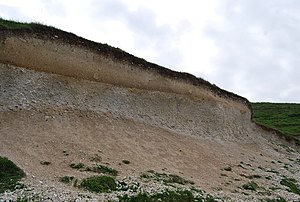
Back علم دراسة التربة Arabic প্রাকৃতিক মৃত্তিকাবিজ্ঞান Bengali/Bangla Pedologija BS Pedologia Catalan Tū-iōng-hŏk CDO Pedologie Czech Priddeg Welsh Pedologie German Pedologio Esperanto Pedología Spanish

Pedology (from Greek: πέδον, pedon, "soil"; and λόγος, logos, "study") is a discipline within soil science which focuses on understanding and characterizing soil formation, evolution, and the theoretical frameworks for modeling soil bodies, often in the context of the natural environment.[1] Pedology is often seen as one of two main branches of soil inquiry, the other being edaphology which is traditionally more agronomically oriented and focuses on how soil properties influence plant communities (natural or cultivated). In studying the fundamental phenomenology of soils, e.g. soil formation (aka pedogenesis), pedologists pay particular attention to observing soil morphology and the geographic distributions of soils, and the placement of soil bodies into larger temporal and spatial contexts. In so doing, pedologists develop systems of soil classification, soil maps, and theories for characterizing temporal and spatial interrelations among soils . There are a few noteworthy sub-disciplines of pedology; namely pedometrics and soil geomorphology. Pedometrics focuses on the development of techniques for quantitative characterization of soils, especially for the purposes of mapping soil properties[2] whereas soil geomorphology studies the interrelationships between geomorphic processes and soil formation.[3]
- ^ Ronald Amundsen. "Soil Preservation and the Future of Pedology" (PDF). Archived from the original (PDF) on 2018-06-12. Retrieved 2006-06-08.
- ^ Heuvelink, Gerard (December 2003). "The Definition of Pedometrics" (PDF). Pedometron (15). International Working Group on Pedometrics - Provisional Commission on Pedometrics of the International Union of Soil Sciences. Archived from the original (PDF) on 2007-09-30. Retrieved 2006-11-01.
- ^ Gerrard, John (1993), "Soil geomorphology — Present dilemmas and future challenges", Geomorphology: the Research Frontier and Beyond, Elsevier, pp. 61–84, doi:10.1016/b978-0-444-89971-2.50008-0, ISBN 978-0-444-89971-2, retrieved 2020-09-23